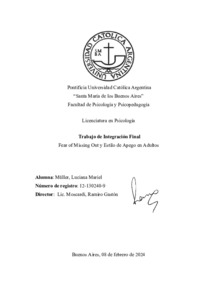Por favor, use este identificador para citar o enlazar este ítem:
https://repositorio.uca.edu.ar/handle/123456789/18632| Campo DC | Valor | Lengua/Idioma |
|---|---|---|
| dc.contributor.advisor | Moscardi, Ramiro Gastón | es |
| dc.contributor.author | Müller, Luciana Mariel | es |
| dc.date.accessioned | 2024-08-29T12:46:05Z | - |
| dc.date.available | 2024-08-29T12:46:05Z | - |
| dc.date.issued | 2024 | - |
| dc.identifier.uri | https://repositorio.uca.edu.ar/handle/123456789/18632 | - |
| dc.description.abstract | La presente investigación buscó identificar y describir las dimensiones de apego y la existencia de FoMO en 69 adultos de ambos géneros del Área Metropolitana de Buenos Aires de 18 a 30 años de edad. En cuanto a los objetivos planteados, la intención fue describir los estilos de apego presentes en la muestra, los niveles de FoMO, la relación entre ambos, como así también la existencia de diferencias entre género. Se encontraron diferencias significativas en la dimensión de apego evitativo en favor del género femenino (M=24,40, p=0,015). No se encontraron diferencias estadísticamente significativas para FoMO (p=0,084) según el género. Se encontró una correlación positiva fuerte entre el Apego Ansioso y el FoMO (r = 0,601; p = 0,000), es decir, a mayor presencia del Apego Ansioso mayor presencia de FoMO. A su vez, si bien menos fuerte, se encontró una correlación positiva entre Apego Evitativo y el FoMO (r = 0,254; p = 0,035) y en Apego Seguro y el FoMO (r=0,299; p=0,013). | es |
| dc.description.abstract | The present research aimed to identify and describe attachment dimensions and the existence of FoMO in 69 adults of both genders from the Buenos Aires Metropolitan Area aged 18 to 30 years old. Regarding the objectives outlined, the intention was to describe attachment styles, levels of FoMO, the relationship between both, as well as the existence of differences between genders. Statistically significant differences were found in the dimension of avoidant attachment in favor of the female gender (M=24.40, p=0.015). No statistically significant differences were found for FoMO (p=0.084) by gender. A strong positive correlation was found between Anxious Attachment and FoMO (r = 0.601; p = 0.000), meaning that a greater presence of Anxious Attachment corresponds to a greater presence of FoMO. Furthermore, although less strong, a positive correlation was found between Avoidant Attachment and FoMO (r = 0.254; p = 0.035) and between Secure Attachment and FoMO (r=0.299; p=0.013). | es |
| dc.format | application/pdf | es |
| dc.language.iso | spa | es |
| dc.rights | Atribución-NoComercial-CompartirIgual 4.0 Internacional | * |
| dc.rights.uri | http://creativecommons.org/licenses/by-nc-sa/4.0/ | * |
| dc.source | Tesis de Licenciatura. Pontificia Universidad Católica Argentina. Facultad de Psicología y Psicopedagogía, 2024 | es |
| dc.subject | FEAR OF MISSING OUT | es |
| dc.subject | APEGO | es |
| dc.subject | REDES SOCIALES | es |
| dc.title | Fear of missing out y estilo de apego en adultos | es |
| dc.type | Tesis de grado | es |
| uca.disciplina | PSICOLOGIA | es |
| uca.issnrd | 1 | es |
| uca.affiliation | Fil: Müller, Luciana Mariel. Pontificia Universidad Católica Argentina. Facultad de Psicología y Psicopedagogía; Argentina | es |
| uca.affiliation | Fil: Moscardi, Ramiro Gastón. Pontificia Universidad Católica Argentina. Facultad de Psicología y Psicopedagogía; Argentina | es |
| uca.version | publishedVersion | es |
| item.fulltext | With Fulltext | - |
| item.grantfulltext | open | - |
| item.languageiso639-1 | es | - |
| Aparece en las colecciones: | Licenciatura en Psicología | |
Ficheros en este ítem:
| Fichero | Descripción | Tamaño | Formato | |
|---|---|---|---|---|
| fear-missing-out.pdf | 610,75 kB | Adobe PDF |  Visualizar/Abrir |
Este ítem está sujeto a una Licencia Creative Commons

